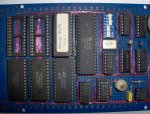Hi,
There are on sale drilled boards (2.54 mm pitch) with no copper traces.
What are they used for? How are the components installed on them and the connections made?
I also saw boards where each hole has its own pad and all the pads are separate from each other. How are the connections between pads made?
There are on sale drilled boards (2.54 mm pitch) with no copper traces.
What are they used for? How are the components installed on them and the connections made?
I also saw boards where each hole has its own pad and all the pads are separate from each other. How are the connections between pads made?


